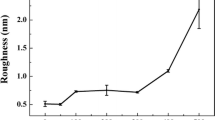Abstract
Hydrogenated amorphous silicon (a-Si:H) films were deposited by reactive facing target sputtering (FTS) technique with a mixture of Ar and H2 reaction gas. Fourier transform infrared (FTIR) absorption, Raman scattering and ultraviolet-visible optical absorption are used to investigate the microstructure and optical properties of the deposited films. The decrease of the concentration of bonded hydrogen, especially that of (Si-H2) n with increasing substrate temperature (Ts), was observed in FTIR spectra, suggesting the atomic density increases and the concentration of microvoids decrease in a-Si:H films. The increase of both the short range order and the intermediate range order of amorphous network for a-Si:H films were verified by Raman scattering spectra, in which increasing Ts decreasing the band width of TO and the scattering intensity ratio I TA/I TO were obtained. All above results clarify the effect of increasing Ts on the microstructure amelioration for a-Si:H films. The reduction of disordered domains is correlated with the film growing process, where the increased surface diffusion mobility and etching of weak bonds is induced by increasing Ts. Furthermore, analysis of optical absorption indicates that the films with a lower optical band gap and a narrower band edge can be obtained by this FTS technique.
Similar content being viewed by others
References
Tomonori N, Madoka T, Hiroomi M. Amorphous silicon solar cells deposited at high growth rate. J Non-Cryst Solids, 2002, 299–302: 1116–1122
Hishikawa Y, Tsuda S, Wakisaka K. Principles for controlling the optical and electrical properties of hydrogenated amorphous silicon deposited from a silane plasma. J Appl Phys, 1993, 73: 4227–4231
Okamoto S, Hishikawa Y, Tsuge S. High-quality wide-gap hydrogenated amorphous silicon fabricated using hydrogen plasma post-treatment. Jpn J Appl Phys, 1994, 33: 1773–1777
Baghdad R, Benlakehal D, Portier X, et al. Deposition of nanocrystalline silicon thin films: Effect of total pressure and substrate temperature. Thin Solid Films, 2008, 516: 3965–3970
Pinarbasi M, Maley N, Myers A M. Hydrogenated amorphous silicon films deposited by reactive sputtering: The electronic properties, hydrogen bonding and microstructure. Thin Solid Films, 1989, 171: 217–233
Pinarbasi M, Kushner M J, Abelson J R. Effect of hydrogen content on the light induced defect generation in direct current magnetron reactively sputtered hydrogenated amorphous silicon thin films. J Appl Phys, 1990, 68: 2255–2264
Morito M, Yoichi H, Masahiko N. Reactive synthesis of well-oriented zinc-oxide films by the facing targets sputtering method. J Appl Phys, 1988, 63(6): 2098–2103
Haw-M K, Woo-Pyo H. Preparation of SiOxNy films by facing target sputtering system for thin film passivation layers of OLEDs. J Korean Phys Soc, 2008, 53(3): 1665–1670
Connell G A N, Pawlik J R. Use of hydrogenation in structural and electronic studies of gap states in amorphous germanium. Phys Rev B, 1976, 13: 787–804
Brodsky G H, Cardona M, Cuomo J J. Infrared and Raman spectra of the silicon-hydrogen bonds in amorphous silicon prepared by glow discharge and sputtering. Phys Rev B, 1977, 16: 3556–3571
Amrani R, Benlekehal D, Baghdad R. Low-temperature growth of nanocrystalline silicon films prepared by RF magnetron sputtering: Structural and optical studies. J Non-Cryst Solids, 2008, 354: 2291–2295
Han D X, Wang K D, Owens J M. Hydrogen structures and the optoelectronic properties in transition films from amorphous to microcrystalline silicon prepared by hot-wire chemical vapor deposition. J Appl Phys, 2003, 93: 3776–3783
Mahan A H, Raboisson P, Tsu R. Influence of microstructure on the photoconductivity of glow discharge deposited amorphous SiC:H and amorphous SiGe:H alloys. Appl Phys Lett, 1987, 50: 335–337
Mahan A H, Raboisson P, Williamson D L. Evidence for microstructure in glow discharge hydrogenated amorphous Si-C alloys. Sol Cells, 1987, 21: 117–126
Mahan A H, Nelson B P, Salamon S. Deposition of device quality, low H content a-Si:H by the hot wire technique. J Non-Cryst Solids, 1991, 137–138: 657–660
Touir H, Zellama K, Morhange J F. Local Si-H bonding environment in hydrogenated amorphous silicon films in relation to structural inhomogeneities. Phys Rev B, 1999, 59: 10076–10083
Chehaider A, Jafari-Rouhani M, Zwick A. Localized vibrational states in amorphous silicon. J Non-Cryst Silids, 1995, 192–193: 238–242
Yamaguchi M, Morigaki K. The correlation between hydrogen content and electronic properties in a-Si:H. J Non-Cryst Silids, 1991, 137–138: 57–60
Biswas R, Bouchard A M, Kamitakahara W A. Vibrational localization in amorphous silicon. Phys Rev Lett, 1988, 60: 2280–2283
Laird D D, Schober H R. Localized low-frequency vibrational modes in a simple model glass. Phys Rev Lett, 1991, 66: 636–639
Beeman D, Tsu R, Thorpe M F. Structural information from the Raman spectrum of amorphous silicon. Phys Rev B, 1985, 32: 874–878
Fortner J, Lannin J S. Radial distribution functions of amorphous silicon. Phys Rev B, 1989, 39: 5527–5530
Marinov M, Zotov N. Model investigation of the Raman spectra of amorphous silicon. Phys Rev B, 1997, 55: 2938–2944
Tsu R, Menna P, Mahan A H. Optical absorption and disorder in hydrogenated amorphous Si-Ge and Si-C alloy systems. Sol Cell, 1987, 21: 189–194
Cody G D, Wronski C R, Abeles B. Optical characterization of amorphous silicon hydride films. Sol Cells, 1980, 2: 227–243
Kshirsager S T, Lannin J S. Structural order in anneal-stable amorphous silicon. Phys Rev B, 1982, 25: 2916–2919
Abelson J R. Properties of Amorphous Silicon. Fritzsche H, ed. 2nd ed. EMIS Data Reviews Series No. 1.: Inspec Publication, 1989. 273
Crandle R S, Liu X, Iwaniczko E. Recent developments in hot wire amorphous silicon. J Non-Cryst Solids, 1998, 227–230: 23–28
Author information
Authors and Affiliations
Corresponding author
Rights and permissions
About this article
Cite this article
Yu, W., Meng, L., Yuan, J. et al. Influence of substrate temperature on growth of a-Si:H films by reactive facing target sputtering deposition. Sci. China Phys. Mech. Astron. 53, 807–811 (2010). https://doi.org/10.1007/s11433-010-0193-z
Received:
Accepted:
Published:
Issue Date:
DOI: https://doi.org/10.1007/s11433-010-0193-z




